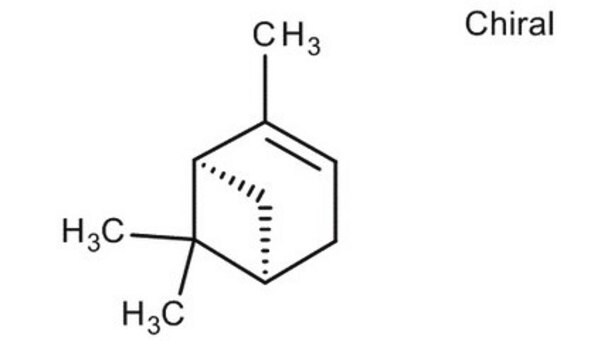P45680
(+)-α-Pinene
98%
Synonym(s):
(1R,5R)-2,6,6-Trimethylbicyclo[3.1.1]hept-2-ene, (1R,5R)-2-Pinene
About This Item
Recommended Products
Assay
98%
optical activity
[α]/D 35 to 54, neat
optical purity
ee: ≥85% (GLC)
autoignition temp.
491 °F
refractive index
n20/D 1.465 (lit.)
bp
155-156 °C (lit.)
mp
−62 °C (lit.)
density
0.858 g/mL at 20 °C (lit.)
SMILES string
CC1=CC[C@@H]2C[C@H]1C2(C)C
InChI
1S/C10H16/c1-7-4-5-8-6-9(7)10(8,2)3/h4,8-9H,5-6H2,1-3H3/t8-,9-/m1/s1
InChI key
GRWFGVWFFZKLTI-RKDXNWHRSA-N
Looking for similar products? Visit Product Comparison Guide
General description
Application
- To prepare chiral organoboranes, which are used in the synthesis of optically active compounds and in Suzuki coupling.
- In the synthesis of chiral pyridine-type N-oxides as catalysts for the allylation of aromatic aldehydes.
- To synthesize 2,3-pinane diamine, a chiral auxiliary in several catalysts and reagents.
Signal Word
Danger
Hazard Statements
Precautionary Statements
Hazard Classifications
Aquatic Acute 1 - Asp. Tox. 1 - Flam. Liq. 3 - Skin Irrit. 2 - Skin Sens. 1
Storage Class Code
3 - Flammable liquids
WGK
WGK 3
Flash Point(F)
91.4 °F - closed cup
Flash Point(C)
33 °C - closed cup
Personal Protective Equipment
Certificates of Analysis (COA)
Search for Certificates of Analysis (COA) by entering the products Lot/Batch Number. Lot and Batch Numbers can be found on a product’s label following the words ‘Lot’ or ‘Batch’.
Already Own This Product?
Find documentation for the products that you have recently purchased in the Document Library.
Customers Also Viewed
Chromatograms
suitable for GCsuitable for GCsuitable for GCOur team of scientists has experience in all areas of research including Life Science, Material Science, Chemical Synthesis, Chromatography, Analytical and many others.
Contact Technical Service











